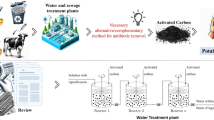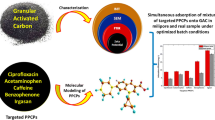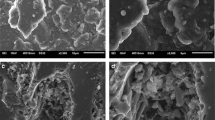Abstract
Given their voluminous application, significant amounts of fluoroquinolones are discharged into the environment through wastewater effluent. Adsorption has been shown to be a critical process controlling the environmental behaviors of fluoroquinolones. Competition between ofloxacin (OFL) and naphthalene (NAP)/bisphenol A (BPA) and their adsorption on activated carbon (AC), graphite (GP), and humic acid (HA) were investigated. The suppressed adsorption of OFL was observed on AC and GP, but not on HA, by NAP or BPA. Moreover, for AC, the competition by NAP was slightly stronger than that by BPA. However, for GP, the competition with BPA was higher than that with NAP. These observations indicate that competitive adsorption of OFL with respect to NAP/BPA depends on the degree of overlap of adsorption sites, as interpreted by the following: (i) AC can provide overlapping adsorption sites for OFL, BPA, and NAP, which include non-specific adsorption sites, such as hydrophobic sites, π-π interactions, and micropore filling; (ii) π-π interactions and hydrogen bonding might be responsible for the strong competitive adsorption between BPA and OFL on GP; and (iii) OFL adsorbs on HA through specific adsorption force—electrostatic attraction, with which NAP and BPA cannot compete.





Similar content being viewed by others
References
Al-Ahmad A, Daschner F, Kümmerer K (1999) Biodegradability of cefotiam, ciprofloxacin, meropenem, penicillin G, and sulfamethoxazole and inhibition of waste water bacteria. Arch Environ Contam Toxicol 37(2):158–163
Batt AL, Bruce IB, Aga DS (2006) Evaluating the vulnerability of surface waters to antibiotic contamination from varying wastewater treatment plant discharges. Environ Pollut 142(2):295–302
Blanchard G, Maunaye M, Martin G (1984) Removal of heavy metals from waters by means of natural zeolites. Water Res 18(12):1501–1507
Bonin JL, Simpson MJ (2007) Sorption of steroid estrogens to soil and soil constituents in single- and multi-sorbate systems. Environ Toxicol Chem 26(12):2604–2610
Calamari D, Zuccato E, Castiglioni S, Bagnati R, Fanelli R (2003) Strategic survey of therapeutic drugs in the rivers Po and Lambro in northern Italy. Environ Sci Technol 37(7):1241–1248
Campagnolo ER, Johnson KR, Karpati A, Rubin CS, Kolpin DW, Meyer MT, Esteban JE, Currier RW, Smith K, Thu KM (2002) Antimicrobial residues in animal waste and water resources proximal to large-scale swine and poultry feeding operations. Sci Total Environ 299(1):89–95
Carter MC, Kilduff JE, Weber WJ (1995) Site energy distribution analysis of preloaded adsorbents. Environ Sci Technol 29(7):1773–1780
Castiglioni S, Bagnati R, Fanelli R, Pomati F, Calamari D, Zuccato E (2006) Removal of pharmaceuticals in sewage treatment plants in Italy. Environ Sci Technol 40(1):357–363
Chen W, Duan L, Zhu D (2007) Adsorption of polar and nonpolar organic chemicals to carbon nanotubes. Environ Sci Technol 41(24):8295–8300
Conkle JL, Lattao C, White JR, Cook RL (2010) Competitive sorption and desorption behavior for three fluoroquinolone antibiotics in a wastewater treatment wetland soil. Chemosphere 80(11):1353–1359
Deng S, Bai RB (2003) Aminated polyacrylonitrile fibers for humic acid adsorption: behaviors and mechanisms. Environ Sci Technol 37(24):5799–5805
Gao Y, Li Y, Zhang L, Huang H, Hu J, Shah SM, Su X (2012) Adsorption and removal of tetracycline antibiotics from aqueous solution by graphene oxide. J Colloid Interface Sci 368(1):540–546
Golet EM, Alder AC, Giger W (2002) Environmental exposure and risk assessment of fluoroquinolone antibacterial agents in wastewater and river water of the Glatt Valley Watershed, Switzerland. Environ Sci Technol 36(17):3645–3651
Gotovac S, Hattori Y, Noguchi D, Miyamoto JI, Kanamaru M, Utsumi S, Kanoh H, Kaneko K (2006) Phenanthrene adsorption from solution on single wall carbon nanotubes. J Phys Chem B 110(33):16219–16224
Gupta V, Khamparia S, Tyagi I, Jaspal D, Malviya A (2015) Decolorization of mixture of dyes: a critical review. Glob J Environ Sci Manag 1(1):71–94
Hou J, Pan B, Niu X, Chen J, Xing B (2010) Sulfamethoxazole sorption by sediment fractions in comparison to pyrene and bisphenol A. Environ Pollut 158(9):2826–2832
Hu J, Wang W, Zhu Z, Chang H, Pan F, Lin B (2007) Quantitative structure−activity relationship model for prediction of genotoxic potential for quinolone antibacterials. Environ Sci Technol 41(13):4806–4812
Huang W, Weber WJ (1997) Thermodynamic considerations in the sorption of organic contaminants by soils and sediments. 1. The isosteric heat approach and its application to model inorganic sorbents. Environ Sci Technol 31(11):3238–3243
Jaspal D, Malhotra S, Malviya A (2012) Column studies for the adsorption of brilliant green, fast green FCF and phenol red dyes on de-oiled soya and bottom ash. Asian J Chem 24(11):5082
Ji L, Chen W, Zheng S, Xu Z, Zhu D (2009) Adsorption of sulfonamide antibiotics to multiwalled carbon nanotubes. Langmuir 25(19):11608–11613
Ji L, Liu F, Xu Z, Zheng S, Zhu D (2010) Adsorption of pharmaceutical antibiotics on template-synthesized ordered micro-and mesoporous carbons. Environ Sci Technol 44(8):3116–3122
Kadirvelu K, Thamaraiselvi K, Namasivayam C (2001) Removal of heavy metals from industrial wastewaters by adsorption onto activated carbon prepared from an agricultural solid waste. Bioresour Technol 76(1):63–65
Khamparia S, Jaspal DK (2016) Evaluation of decoloration potential of Xanthium Strumarium seed hull for adsorption of Direct red 81 in aqueous solution. Environ Dev Sustain:1–19
Khamparia S, Jaspal DK (2017a) Xanthium strumarium L. seed hull as a zero cost alternative for Rhodamine B dye removal. J Environ Manag 197:498–506
Khamparia S, Jaspal DK (2017b) Adsorption in combination with ozonation for the treatment of textile waste water: a critical review. Front Environ Sci Eng 11(1):8
Kolpin DW, Furlong ET, Meyer MT, Thurman EM, Zaugg SD, Barber LB, Buxton HT (2002) Pharmaceuticals, hormones, and other organic wastewater contaminants in US streams, 1999–2000: a national reconnaissance. Environ Sci Technol 36(6):1202–1211
Kümmerer K (2009) Antibiotics in the aquatic environment—a review—part I. Chemosphere 75(4):417–434
Lee LS, Carmosini N, Sassman SA, Dion HM, Sepulveda MS (2007) Agricultural contributions of antimicrobials and hormones on soil and water quality. Adv Agron 93:1–68
Malviya A, Jaspal D, Sharma P, Dubey A (2015) Isothermal mathematical modeling for decolorizing water—a comparative approach. Sustain Environ Res 25(1)
Malviya A, Kaur D (2012) Removal of toxic Azo dyes from wastewater using bottom ash—equilibrium isothermal modeling. Orient J Chem 28(2):955
Miao XS, Bishay F, Chen M, Metcalfe CD (2004) Occurrence of antimicrobials in the final effluents of wastewater treatment plants in Canada. Environ Sci Technol 38(13):3533–3541
Pelekani C, Snoeyink VL (2000) Competitive adsorption between atrazine and methylene blue on activated carbon: the importance of pore size distribution. Carbon 38(10):1423–1436
Peng H, Pan B, Wu M, Liu Y, Zhang D, Xing B (2012a) Adsorption of ofloxacin and norfloxacin on carbon nanotubes: hydrophobicity- and structure-controlled process. J Hazard Mater 233:89–96
Peng H, Pan B, Wu M, Liu R, Zhang D, Wu D, Xing B (2012b) Adsorption of ofloxacin on carbon nanotubes: solubility, pH and cosolvent effects. J Hazard Mater 211:342–348
Peng B, Chen L, Que C, Yang K, Deng F, Deng X, Shi G, Xu G, Wu M (2016) Adsorption of antibiotics on graphene and biochar in aqueous solutions induced by π-π interactions. Sci Rep 6:31920
Picó Y, Andreu V (2007) Fluoroquinolones in soil—risks and challenges. Anal Bioanal Chem 387(4):1287–1299
Renew JE, Huang CH (2004) Simultaneous determination of fluoroquinolone, sulfonamide, and trimethoprim antibiotics in wastewater using tandem solid phase extraction and liquid chromatography–electrospray mass spectrometry. J Chromatogr A 1042(1):113–121
Sander M, Pignatello JJ (2005) Characterization of charcoal adsorption sites for aromatic compounds: insights drawn from single-solute and bi-solute competitive experiments. Environ Sci Technol 39(6):1606–1615
Wang Y, Lu J, Wu J, Liu Q, Zhang H, Jin S (2015) Adsorptive removal of fluoroquinolone antibiotics using bamboo biochar. Sustainability 7(9):12947–12957
Wu D, Li H, Liao S, Sun X, Peng H, Zhang D, Pan B (2014) Co-sorption of ofloxacin and Cu (II) in soils before and after organic matter removal. Sci Total Environ 481:209–216
Wu M, Pan B, Zhang D, Xiao D, Li H, Wang C, Ning P (2013) The sorption of organic contaminants on biochars derived from sediments with high organic carbon content. Chemosphere 90(2):782–788
Xia GS, Ball WP (2000) Polanyi-based models for the competitive sorption of low-polarity organic contaminants on a natural sorbent. Environ Sci Technol 34(7):1246–1253
Yang K, Wang X, Zhu L, Xing B (2006) Competitive sorption of pyrene, phenanthrene, and naphthalene on multiwalled carbon nanotubes. Environ Sci Technol 40(18):5804–5810
Ye Z, Weinberg HS, Meyer MT (2007) Trace analysis of trimethoprim and sulfonamide, macrolide, quinolone, and tetracycline antibiotics in chlorinated drinking water using liquid chromatography electrospray tandem mass spectrometry. Anal Chem 79(3):1135–1144
Zhang D, Pan B, Wu M, Zhang H, Peng H, Ning P, Xing B (2012) Cosorption of organic chemicals with different properties: their shared and different sorption sites. Environ Pollut 160:178–184
Zhao J, Buldum A, Han J, Lu JP (2002) Gas molecule adsorption in carbon nanotubes and nanotube bundles. Nanotechnology 13(2):195
Zhou D, Chen B, Wu M, Liang N, Zhang D, Li H, Pan B (2014) Ofloxacin sorption in soils after long-term tillage: the contribution of organic and mineral compositions. Sci Total Environ 497:665–670
Acknowledgements
This work was supported by the National Natural Science Foundation of China (41663414).
Author information
Authors and Affiliations
Corresponding author
Additional information
Responsible editor: Guilherme L. Dotto
Electronic supplementary material
ESM 1
(DOCX 20 kb).
Rights and permissions
About this article
Cite this article
Wang, C., Ma, L., Liu, B. et al. Co-contaminant effects on ofloxacin adsorption onto activated carbon, graphite, and humic acid. Environ Sci Pollut Res 24, 23834–23842 (2017). https://doi.org/10.1007/s11356-017-0038-7
Received:
Accepted:
Published:
Issue Date:
DOI: https://doi.org/10.1007/s11356-017-0038-7




